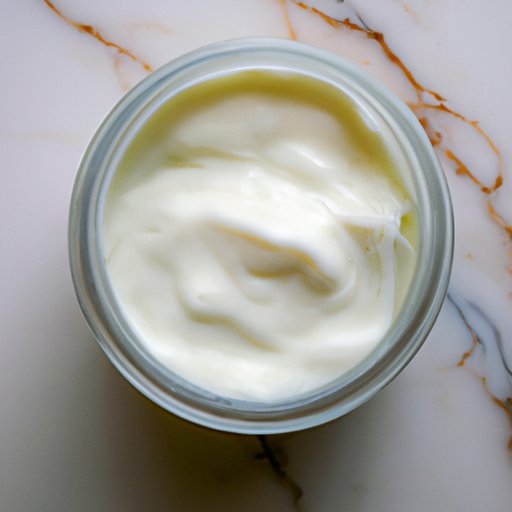
I. Introduction
Heavy cream is a staple ingredient in many recipes, from soups to sauces to desserts. However, what do you do when you don’t have any heavy cream on hand? Perhaps you want to make a dairy-free dish, or maybe you’re trying to make healthier choices in your cooking. Whatever the reason, this article will provide you with alternatives to heavy cream and offer suggestions on how to use them in your cooking.
II. Dairy-Free Alternatives to Heavy Cream
If you’re looking for a dairy-free alternative to heavy cream, you have several options at your disposal. Soy milk, coconut milk, and almond milk are all excellent choices. Soy milk has a thicker texture than other non-dairy milks, making it a particularly good substitute for heavy cream in soups and sauces. Coconut milk gives a rich and creamy texture to dishes and is a great choice for curries or Asian-inspired recipes. Almond milk has a lighter texture and is a good option for baking or in recipes that require a subtle flavor.
To use these dairy-free alternatives as a substitute for heavy cream, measure out the same amount of milk as you would have used for heavy cream. Be aware that the texture and flavor may be slightly different from the original recipe, but these alternatives should work well in most recipes.
III. 5 Healthy Substitutes for Heavy Cream in Your Cooking
If you’re looking for healthy alternatives to heavy cream, there are several options available. Cottage cheese can be blended or pureed to create a creamy texture that works well in sauces and dips. Evaporated milk is a great option for dishes that require a thicker texture, like casseroles or creamed vegetables. Cashew cream, made by pureeing soaked and drained cashews, is a good substitute for heavy cream in vegan recipes.
To use these healthy substitutes, you’ll need to adjust the recipe accordingly. For example, if using cottage cheese, blend it with a small amount of liquid until it reaches the desired consistency. If using evaporated milk, use half the amount of heavy cream called for in the recipe and add additional thickener if necessary.
IV. How to Get Creamy Texture without Heavy Cream
If you don’t have access to any of the alternatives mentioned above, there are still ways to achieve a creamy texture in your dishes. One method is to simmer the liquid down until it reaches a thicker consistency. You can also use either a roux or a beurre manie to thicken soups and sauces. Finally, blending vegetables or nuts can create a creamy texture without the use of heavy cream.
To use these techniques, follow the recipe instructions for each method. For example, when using a roux, melt butter in a saucepan and add equal parts flour to create a paste. Cook the paste until it browns slightly, then whisk in the liquid until it thickens.
V. Ingredient Swap: Using Greek Yogurt Instead of Heavy Cream
Greek yogurt is a versatile ingredient that can be used as a substitute for heavy cream in many recipes. It has a similar texture and flavor and is lower in fat and calories than heavy cream. Greek yogurt can be used as a replacement in dressings, sauces, dips, and even desserts.
To use Greek yogurt as a substitute, measure out the same amount of yogurt as you would have used for heavy cream. Blend it with other ingredients if necessary, such as herbs or spices, to achieve the desired flavor.
VI. Vegan-Friendly Options to Replace Heavy Cream in Your Recipes
If you’re following a vegan diet, there are several substitutes for heavy cream that you can use. Cashew cream, made by soaking and pureeing cashews, is an excellent option. Silken tofu can also be blended to create a creamy texture in soups and sauces. Coconut cream is another choice that works well in both sweet and savory recipes.
When using vegan substitutes, you may need to adjust the recipe to account for differences in flavor and texture. Experiment with different recipes to find the substitutes that work best for you.
VII. Conclusion
As you can see, there are many alternatives to heavy cream that you can use in your cooking. Whether you’re looking for a dairy-free option or a healthier substitute, there are plenty of choices available. Don’t be afraid to experiment with different substitutes to find the ones that work best for you. Not only can you achieve a similar texture and flavor, but you may also add nutritional benefits or save some money at the grocery store.




